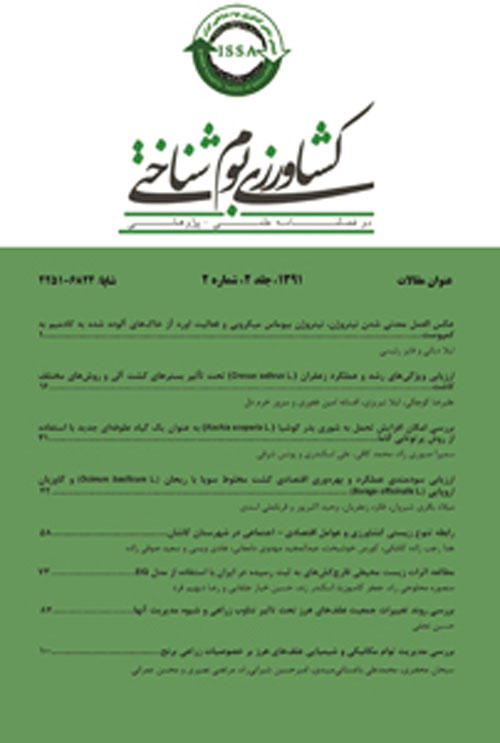Comparison of agroecosystem health in northern provinces of Iran 2002-11
Author(s):
Article Type:
Research/Original Article (دارای رتبه معتبر)
Abstract:
Introduction
In the last century, agroecosystems have been considered as production units despite their range of functions. The variety of methods used to maximize production have had a negative impact on the dimensions and functions of the agroecosystem (Alkorta et al., 2004). Industrial agriculture methods have resulted in a series of negative environmental effects such as contamination of surface drainage and groundwater with pesticides and highly-soluble chemical fertilizers, soil compaction by excessive use of machinery, reduction in biodiversity, overexploitation of natural resources, and high rates of carbon emission due to direct or indirect consumption of petroleum. In different parts of the world, especially in developed countries, the expansion of agricultural lands and the intensification of production methods reach their socioeconomic and environmental limitations. Therefore sustainable agriculture with its holistic principles have a key role in finding solutions for these challenges. The correct management of soil, water and fertilizer is critical for sustainable agriculture, because such management can increase food production and enhance the quality of the environment. Evaluation of different aspects of agroecosystem health (i.e. structural, functional, and organizational) is an acceptable method for monitoring and comparing systems (Xu and Mage, 2001). The current study has been performed to determine the trend of changes in agroecosystem health in the three northern provinces of Iran.Materials And Methods
The current survey was conducted in order to compare the health status of agroecosystems in three important Northern provinces of Iran (Gilan, Mazandaran and Golestan) during the period of 2002-11. The required data and information was obtained from a formal statistical database. Different indicators selected and calculated based on their scientific definitions (Mohammadi et al., 2016; Vafabakhsh et al., 2007) and for each year the total numerical value for health conditions was calculated using different indicators. Because of the different nature of selected indicators and also their wide range, in order to facilitate a comparison of all the calculated indicators normalized using the appropriate equations.Results And Discussion
Based on results in all of the studied years, the highest value of structural health calculated was for Mazandaran Province and the lowest value was for Gilan Province. In all three provinces, the trend of changes in structural health during the study period was incremental. It seems that in Mazandaran, the higher values for some of the calculated indicators such as area pressurized irrigation, machinery applications, cropping intensity, and agronomic diversity improved the structural health compared to other provinces under study. The same results were also observed for functional health and in all years of study except 2004, the highest values of functional health calculated for Mazandaran agro-ecosystems. The main reasons for better conditions of functional health in Mazandaran were higher values of different indicators such as yield of irrigated and dryland cereals, yield of pulses and kitchen garden plants, production costs and nitrogen use efficiency. The organizational health status was somewhat different. During the first six years the organizational health in Golestan was higher, while in the rest of the years Mazandaran had better organizational health status than the other two provinces. The higher organizational health in Golestan was due to the higher value of different indicators such as dryland cropping intensity, dryland area/irrigated land area, application of chemical fertilizers and application of chemical pesticides.Conclusion
Based on the results during the years of study, the total agroecosystem health in Mazandaran was higher than in the two other provinces. Golestan ranked second and Gilan third. The structural and organizational health of agroecosystems in Mazandaran had a more effective role in its higher health. Agroecosystems of Gilan were weakest in all three criteria. In Golestan, the organizational health of agroecosystems was better than functional and structural health.Language:
Persian
Published:
Journal of Agroecology, Volume:8 Issue: 1, 2018
Page:
1
https://magiran.com/p1846573
دانلود و مطالعه متن این مقاله با یکی از روشهای زیر امکان پذیر است:
اشتراک شخصی
با عضویت و پرداخت آنلاین حق اشتراک یکساله به مبلغ 1,390,000ريال میتوانید 70 عنوان مطلب دانلود کنید!
اشتراک سازمانی
به کتابخانه دانشگاه یا محل کار خود پیشنهاد کنید تا اشتراک سازمانی این پایگاه را برای دسترسی نامحدود همه کاربران به متن مطالب تهیه نمایند!
توجه!
- حق عضویت دریافتی صرف حمایت از نشریات عضو و نگهداری، تکمیل و توسعه مگیران میشود.
- پرداخت حق اشتراک و دانلود مقالات اجازه بازنشر آن در سایر رسانههای چاپی و دیجیتال را به کاربر نمیدهد.
In order to view content subscription is required
Personal subscription
Subscribe magiran.com for 70 € euros via PayPal and download 70 articles during a year.
Organization subscription
Please contact us to subscribe your university or library for unlimited access!


